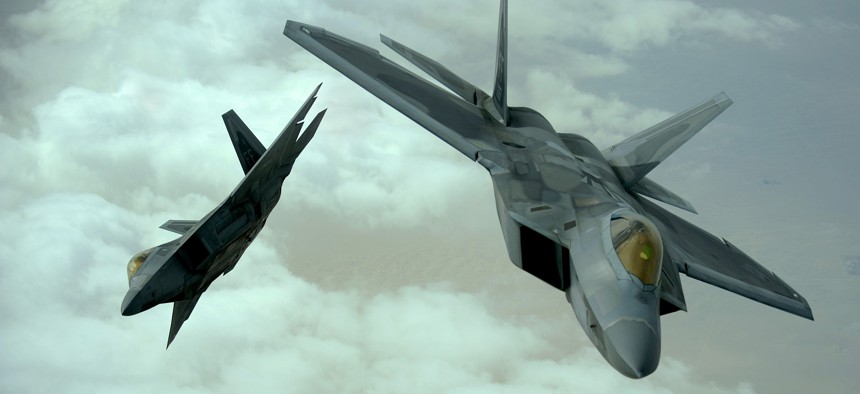
U.S. Air Force F-22 Raptors fly in formation during a training mission, Dec. 6, 2009. U.S. Air Force photo by Staff Sgt. Michael B. Keller
As US Bombs ISIS, Be Wary of Moscow’s Spies
Does the USAF really need to fly F-22s where Russia can practice tracking them?
The U.S.-led coalition is expected to step up anti-ISIS airstrikes in the wake of the Paris attacks, but it should do so with prudence — and not for the obvious reasons of minimizing civilian casualties or dampening perceptions of a war on Islam. The U.S. and its allies must weigh their desires to hit ISIS targets against the risk of revealing to the world heretofore-secret information about their weapons to the world.
In September, as Moscow began deploying its own combat aircraft to Syria, it sent along SA-22 Greyhound air defense systems as well. One of Russia’s more advanced air defense weapons, the SA-22 can fire antiaircraft guns and missiles to shoot down threats out to about 18 miles away. But ISIS operates no offensive aircraft, and in any case, the Syrian government already has plenty of air defense systems of its own. So what are the SA-22s doing there?
There’s little chance that Russian leaders are worried about a nascent air threat from ISIS, nor even about a planned attack by NATO aircraft against their ground forces. It’s far more likely that they hope to use the SA-22’s sophisticated antennae to sniff out and capture various electromagnetic emissions from U.S. and coalition aircraft.
Of particular interest to the Russians, no doubt, is the F-22 Raptor, the stealthy, sensor-filled aircraft that is the world’s most sophisticated fighter jet. In September 2014, F-22 pilots executed their first real-world combat mission, striking targets in Syria as part of the anti-ISIS campaign.
The U.S. has been using the F-22 ever since. What better way to improve SA-22 operability and its software than for it and other Russian intelligence organizations to monitor the operations of the F-22 and other aircraft in a highly active conflict zone? The information obtained can be put to use enhancing improving tracking algorithms, air defense capabilities, and understanding of coalition weapons that are engaging in close air support and precision air strikes.
Making matters worse, Russia recently sent a Moskva warship to the Syrian coast, where its S-300 Grumble air defense system can pick up signals up to 90 miles away. A Russian military source said it was deployed to “test the efficiency of the system protecting the air base near Latakia from air strikes.” It’s not clear which system was being tested, but Russia has also sent its S-400 Triumf — a 250-mile air defense system considered among the world’s best, and even capable of shooting down stealthy aircraft like the F-22. Less than 3 days after the Russian Su-24 was shot down by Turkish fighters, Russia deployed S-400s to Khmeimim airbase near the Syrian port of Latakia to “enhance air defenses.”
The deployment of these sensitive air defense systems mean the U.S. must weigh its desire to hit ISIS targets against the strategic need to conceal its weapons characteristics and operating emissions from Russia. Such “war-gaming practice” and collection activities gives Russian anti-access/area-denial specialists the space, time, and data to improve their air defense systems and software.
So what should the U.S. do differently? Stop using the F-22 in Syria; its stealth is hardly needed, and each mission it flies allows Moscow to practice tracking it. Limit the use of other advanced avionics, limiting Russian intelligence attempts to collect information and reshape their weapons, doctrine, strategy, operations, and tactics. The A-10 is the sort of aircraft best suited for this type of operating environment, primarily for its incredible firepower and its low-end technology and avionics on-board.
If the U.S. cannot muster the prudence to stop exposing its most advanced aircraft, avionics, and tactics, it risks losing the next battle to an enemy that actually has the capability to shoot down U.S. and allied aircraft.
NEXT STORY: Don’t Avenge Paris



